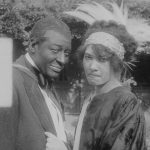
The Museum of Modern Art announces the discovery of previously unidentified, 101-year-old film footage, the earliest known surviving feature film with a cast of black actors. The unedited daily rushes—multiple “takes” shot each day during production—were found among a trove of 900 negatives from the pioneering Biograph Studio that were acquired by MoMA’s founding Film curator, Iris Barry, in 1939, just prior to their scheduled destruction following the closure of Biograph’s Bronx facilities. Though a few other movies from that period featuring black casts, such as William Foster’s The Pullman Porter (1913) and Hunter C. Haynes’s Uncle Remus’ First Visit to New York (1914) are known to have been filmed, all are considered lost. The discovery of the 1913 rushes launched a multiyear research project to identify the production, its actors, and its crew, led by Ron Magliozzi, Associate Curator, and Peter Williamson, Preservation Officer, Department of Film, MoMA. Selections from the film, along with research findings, archival materials, and film stills will go on view October 24, 2014, in the Roy and Niuta Titus Theater Lobby Galleries in the exhibition 100 Years in Post-Production: Resurrecting a Lost Landmark of Black Film History (through March 2015). The world premiere presentation of the assembled rushes will be on November 8, 2014, in MoMA’s annual film preservation festival To Save and Project (October 24–November 22, 2014), organized by Joshua Siegel, Curator, and Dave Kehr, Adjunct Curator, with Sophie Cavoulacos, Curatorial Assistant, Department of Film, MoMA
Starring the legendary Caribbean American musical theater performer and recording artist Bert Williams (1874–1922), the seven reels of untitled and unassembled rushes were filmed at virtually the same time that D. W. Griffith began The Birth of a Nation
In addition to narrative scenes, the reels reveal candid footage of the black cast and white crew interacting on set, and several frames of Williams mingling with white extras on a suburban street location during a break in filming. The rushes also provide nearly eight minutes of documentary footage of the interracial cast and crew on the New York studio sets and suburban New Jersey locations (in what is believed to be Englewood)

